Ecological Impact of Rare Earth Elements (REE)
| ✓ Paper Type: Free Assignment | ✓ Study Level: University / Undergraduate |
| ✓ Wordcount: 3477 words | ✓ Published: 21 Apr 2021 |
1. Introduction
As discussed in Part A of the research assignment, rare-earth elements (REE) are an important environmental issue, not only from an ecological point of view, given the dichotomy between REEs’ contribution to green technologies and the devastating effects of extracting REEs on all the ecological spheres. Furthermore, Part A highlights tradeoffs between economic benefits to nations and corporations, and social impacts to local populations, both of which are part of the environmental impact of exploitation of REEs (refer to Figure 1).
In section 2 of this assignment, the opposing points of view of different stakeholders in the REE industry will be discussed, both from the point of view of the REE exporters and importers, nations and their corporations that are mostly concerned with economic benefits and costs of REEs. Indeed, there are trade conflicts between the REE exporters and importers on the price of REEs, the cause of which will be discussed further. At the same time, new exporters seek to increase their share of REE exports to enter this lucrative market. However, exporters face opposition from the other main stakeholders, citizens of their countries who are concerned about their environment and social condition, and who oppose the REE exploitation by means of formal complaints and protests. Their circumstances will be explained further.
Next, in section 3, solutions will be proposed to resolve the main issues at stake for REEs. From a scientific point of view, new methods of REE refinement and recycling that have the potential to reduce the ecological impact of REEs will be discussed to resolve the main issue of environmental damage that is at stake for citizens of REE exporters. Furthermore, solutions to resolve REE trade dispute will be proposed, which mainly involve eliminating the monopoly in the REE sector.
To conclude, we will summarize the solutions to each stakeholder’s problem in the REE sector and propose a set of solutions that we consider the most suitable to resolve the disputes between stakeholders equitably.
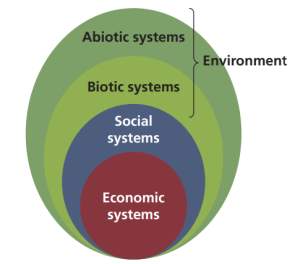
Figure 1. Development within environmental constraints showing place of economic and social systems within environment. Adapted from (Withgott, Laposata, and Murck, 2017).
2. Stakeholders of REEs
Given the growing economic and persistent strategic importance of various applications of REEs, their continued availability is crucial for many nations (Defra, 2011b). The purpose of this section is to serve as a stakeholder position analysis to analyze environmental, economic and social effects and impacts that can be identified across the REE supply chain from both exporter’s and importer’s perspective.
2.1 Exporter stakeholders of REEs
2.1.1 China
As important materials for many high-tech products with no known alternatives, REEs are in high demand in the international market, but supply is limited to only some locations (Schoolderman and Mathlene, 2011). Though China is not the only one that has enough mining resources, Deng Xiaoping, who recognized REEs as important strategic resources, encouraged the production of REEs in China, resulting in China’s role of leading productor of REEs (Hayes-Labruto, Schillebeeckx, Workman, & Shah, 2013), overcoming the US as shown in Figure 2.
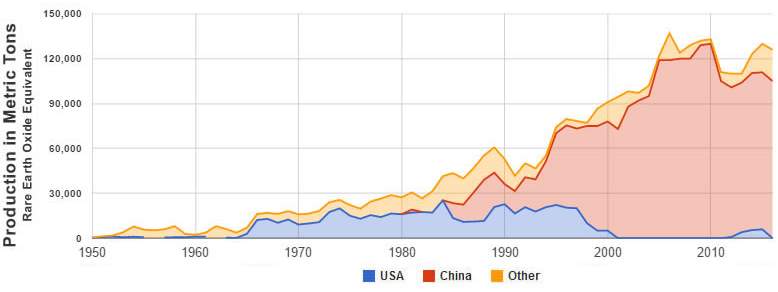
Figure 2. The Global Production of Rare Earth Elements (REEs). Adapted from (Geology.com).
An import-dependence relationship between China and the rest of the world was established. Figure 3 illustrates that China has become the main exporter of REEs with the USA and Japan being the key importers (Hayes-Labruto et al., 2013), leading to the controversial perspectives among different countries. Considering China’s role in the REE market, the positions and perspectives of different stakeholders will be discussed in the economic, environmental, and social sections.
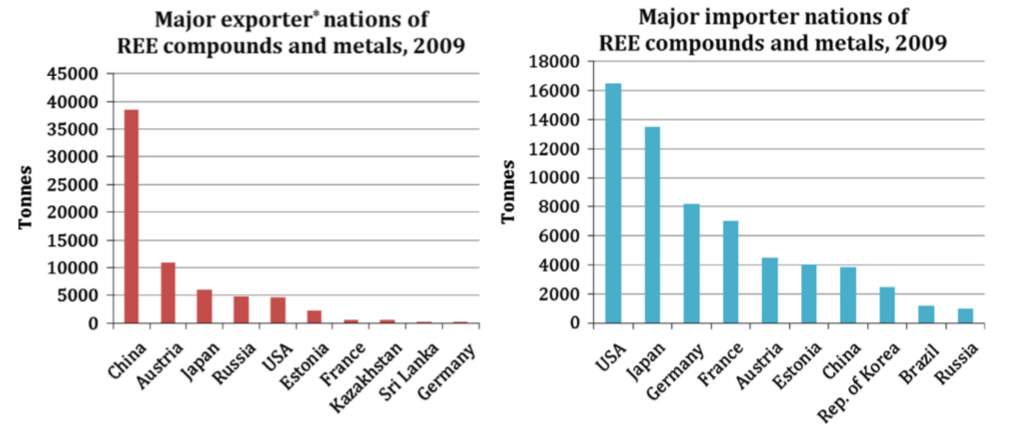
Figure 3. Major exporters and importers of REE compounds and metals in 2009. Adapted from (UN Comtrade, 2009).
Economic dimension
Ever since the “Reform and Opening up” economic reform policy from the 1980s to the 2000s, the Chinese government focused on economic growth and technological advancement: the REEs industry was developed to satisfy both needs (Bryant, 2015). The original policy set by Chinese government created “easy money” from the REEs mining industry, so an increasing number of unregulated and illegal mining operations occurred in this lucrative area, resulting in overproduction, low production efficiency, and destructive domestic competition (Bryant, 2015). As soon as the Chinese government realized that this situation could cause a reduction in price, it decided to ban all new mining licenses and REE separation activities (Bryant, 2015). Moreover, to protect local companies as well as domestic REE reserves, the government gave price advantages to domestic companies and increased the export price of REEs, which led to criticism by stakeholders in other nations who think China is using trade tactics to attract foreign investment and foreign companies to operate in China (Bryant, 2015). One of their perspectives is that China intends to obtain trade secrets and key technologies from foreign companies through this tactic (Bryant, 2015).
Table 1. China’s REEs economic policies. Adapted from (Hayes-Labruto et al., 2013).
| Past situation | Actions and plans |
| Illegal mining and 47 licensed REE producers | Close down and consolidate into 3 SOEs + New policies |
| Wasteful competition with negative externalities | Increase centralized control over pricing and incorporate externalities |
| Cheap prices for REEs | Export taxes + attract investment |
Environmental dimension
One of reasons that led to rapid development of Chinese REEs production is its lax environmental control and inadequate regulations. For example, instead of in situ leaching, China’s industry uses pool leaching which has lower cost and technology requirements, but is more destructive to the environment, (Bryant, 2015). The Chinese government amended the Environment Protection Law and other REE regulations several times to its involvement in environmental protection and push the industry to pay environmental costs (Bryant, 2015). However, these laws would reduce the REE industry’s profits, so they were not implemented properly, due to corruption (Bryant, 2015). As the situation worsened, the Chinese government passed the “Emission Standard of Pollutants for Rare Earth Industry,” which has stricter standards, but by that time, China had most of the international market share (Bryant, 2015). This law and government-mandated export quotas limited China’s REE output (Table 2), which led to trade disputes between China and REE importers (will be discussed in section 2.2).
Table 2 China’s REEs environmental policies. Adapted from (Hayes-Labruto et al., 2013).
| Past situation | Actions and plans |
| Water Pollution | Cut (illegal) production |
| Farmland deterioration | Cut (illegal) production |
| Overexploitation of resources | Cut production and export quota |
| Climate change | Reduce carbon intensity |
Social dimension
Beside the environmental damage, the production of REEs is associated with high risks to human health. As discussed in Part A, the incidence of diseases like pneumoconiosis can be increased. Specifically, villages near the mining site can experience serious repercussions, resulting in indignation of local communities: in 2012 July, the local civil society protested against the environmental pollution due to heavy REE mining activity in Sichuan (Hook, 2012). Furthermore, due to the Baotou Steel Corporation’s disposal of 170 metric tons of REEs and other by-products in standing water, which led to toxic chemicals in drinking water, villagers downstream had to leave their original villages (Gu, 2011). Additionally, the number of complaints about environmental authority rose 30% per year since 2002 (Hayes-Labruto et al., 2013).
Table 3 China’s REEs social policies. Adapted from (Hayes-Labruto et al., 2013).
| Past situation | Actions and plans |
| Human health | Deal with pollution |
| Social unrest | Control, allow and enforce |
| Organized crime | Increase penalties |
| Meet own demand | Ensure local supply |
2.1.2 Australia
Economic dimension
Australia is one of few countries that has significant supplies of REEs, and their production has been rising steadily for the last few years. Australia potentially has a role in world supply, with relatively modest deposits of REEs, of which 31% (two million metric tons of REE and yttrium oxide) are classified as economically demonstrated resources (Geoscience Australia, 2013). An Australia-based corporation, Lynas, is currently operating the Mt. Weld mine in Western Australia and the Malaysian plant in Kuantan, which provide REEs to countries including Japan, Europe, China and North America (Lynas Corporation, 2018). It is thus of significant economic benefit for Australia to develop REE mining at these locations.
Social dimension
Opposing forces in Malaysia appeared and emerged soon after the Lynas Advanced Materials Plant (LAMP) was approved: locals participated in numerous nationwide demonstrations by 2012 when the plant commenced operations: residents are concerned that radioactive waste from the facility will put them at risk and leave a costly legacy (FG Media, 2018). The Malaysian government planned to approve a temporary operating license for LAMP in January 2012, but this was challenged in courts since it breached the Environmental Quality Act of 1974, so the issuance of the license was withheld pending a decision from the Science, Technology and Innovation Minister in April 2012 (FG Media, 2018). Today, the anti-Lynas movement is still very much alive in Malaysia, more than a decade after it first started (FG Media, 2018).
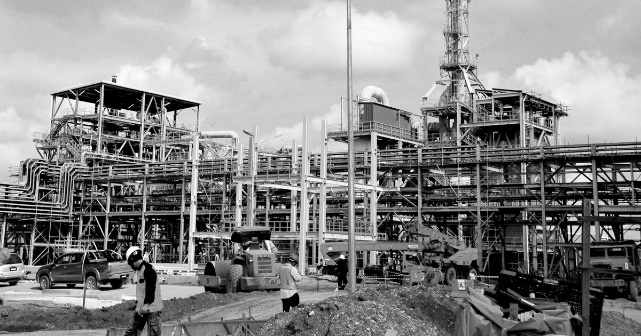
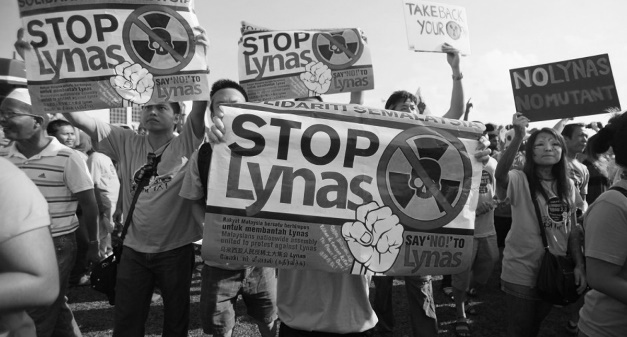
Figure 4. A LAMP facility and an anti-Lynas protest. Adapted from (FG Media, 2018).
2.2 Importer stakeholders of REEs
2.2.1 United States
The United States was the world’s largest supplier of REEs until it was overtaken by China (Figure 2). Now, the US has become dependent on China for REEs, as shown in Figure 4.

Figure 4. Quantity of U.S. REE imports from China and the world 2002-2011 in metric tons. Adapted from (MIT, 2016).
Economic dimension
In 2007, US REE production restarted in Mountain Pass, California (Papp et. al, 2010), explaining the decrease in imports of REEs after 2007 (Figure 4). Molycorp is the only US company mining REEs, but U.S. REEs is another company seeking to begin REE mining in Idaho, Colorado, and Montana (Stewart, 2012). The current position of U.S. mineral policy is to promote a reliable supply of materials for U.S. national security, economy, and industry (Grasso, 2012). This initiative is due to Chinese dominance which has raised concerns within the US industry regarding prices and availability due to Chinese quotas (Grasso, 2012). The US, together with the EU and Japan, brought the case to the WTO as a joint dispute resolution: the U.S. argued that China’s restrictions violated China’s obligations under the WTO, which ruled that China has violated the agreement, but China is appealing the ruling (Grasso, 2012). The economic war is far from over.
Social Dimension
As for legislation, the U.S. government has introduced several bills and held hearings on promoting domestic REE industries: most recently, on July 12, 2012, the House of Representatives passed an act to improve and speed up the process for new REE mining projects (Dobranksy, 2013). The House recognized the need to create a long-term policy for maintaining a sustainable REE strategic reserve, but the Democratic-controlled Senate had a negative reaction to the House measure, since the Obama Administration has voiced its concerns on environmental, government oversight, and legislative wording factors (Dobranksy, 2013). Therefore, the debate on REEs is also a source of contention for national US politics.
2.2.2 Japan
Economic Dimension
Japan is the world’s second-largest consumer of REEs (Figure 3), and relies heavily on imports from China, so it faces issues similar to the US. Indeed, Japan receives 82% of its REEs from China; there is a sense of urgency to secure non-Chinese supplies of REEs (Humphries, 2011). Indeed, China has shown its ability and willingness to control the REE market for political purposes: in September 2011, export of REEs from China to Japan stopped due to a dispute over maritime boundaries; Japan claimed China imposed an embargo of REEs (Humphries, 2011). Moreover, China has placed quotas on the more valuable heavy REEs (Humphries, 2011). China’s monopoly has pushed Japan to search for alternative sources of REEs: the Japanese government wants to invest in the US and other potential REE exporters so that development risk of the Japanese REE industry is reduced (Humphries, 2011).
Social Dimension
Furthermore, Japanese research has recently discovered a deposit of 16 million tons of REEs beneath the seabed in the western Pacific Ocean, which may have significant economic and political impacts (Kuo, 2018). Tokyo hopes it will allow Japan to change its position from importer to exporter of REEs, which would impact the global market significantly and limit China’s ability to use its monopoly as leverage during trade tensions (Kuo, 2018). However, this is not a certain victory over China’s monopoly: currently, there are no profitable methods of exploiting these REEs: producing only 1000 tons of metals would require mining more than one million tons of mud (Kuo, 2018).
2.3 Summary
The above studies discuss the various stakeholder positions and outline their opposing views. The rest of the world seems to perceive China as a resource nationalist that imposes quotas and price fixing after having damaged its environment for decades with REE production. Thus, other countries want to develop their own REE exploitation, to become exporters themselves, or reduce their dependence on China for imports, but in doing so, attract negative attention from their populations, who are opposed to REE mining due to the environmental damages it causes.
3. Solution to environmental problem of REEs
3.1 Science and technology
Separating REEs is expensive, dangerous and time-consuming, because they all have similar chemical characteristics. “Processing one ton of REEs can produce 2,000 tons of toxic waste” (Burrows, 2016). Since mining of REEs has introduced plenty of environmental and economic issues, two ways have been developed to obtain these elements while reducing dependency on mining (Dostal, 2015):
- Finding alternative resources
- Finding ways to recycle REE
Even though the Critical Material Institute has not found any replacements for neodymium and dysprosium used to make high-powered magnets, they have significant success in finding replacements for europium and ytterbium used in cathode ray tubes or fluorescent lights: they have developed red and green phosphors that are nearly or entirely free of REEs (Dostal, 2015).
Recycling REEs sounds very promising; however, it is more expensive than mining. For example, recycling elements in cell phones is very labor-intensive because cell phones are not meant to be opened, and there are several elements in phones that need to be chemically separated for recycling purposes (Dostal, 2015). In addition, tens of thousands of cell phones need to be collected in order to make recycling cell phones worthwhile, so “going where all the REEs are all in one place, and just digging them up is much easier” (Dostal, 2015). However, another form of recycling in the REE industry is more viable: the acid and the water used in the mines can be reused in other mines, which requires a short-term investment for the recycling facilities, but leads to a long-term reduction in expenses (King, 2015).
Alternatively, many approaches can be taken in the process of mining to reduce environmental impact and cost: in order to solve human health-related problems, we can take advantage of harmful chemicals produced during REE mining operation instead of exposing them in open air (Dostal, 2015). During the mining operation, thorium is one of the most commonly found hazards in REE ores, since is radioactive, as discussed in Part A. However, thorium is found to have a lot of excellent properties to be a nuclear fuel, which are listed in Table 4 (King, 2015). Given these properties, thorium could be collected during REE mining operations, stored, and used as fuel for a better nuclear future (King, 2015).
Table 4 Properties of Thorium. Adapted from (King, 2015).
| Property | Effect |
| Alpha emitter | The radiation can be easily shielded and will not hurt humans by penetrating into skin |
| Long half-life of 1.5 billion years | Prevention of easily degeneration and degradation |
| Abundant material | Good substitute for uranium |
To improve the efficiency of REE refinement, new techniques can be adapted into the process. “Researchers from the Harvard John A. Paulson School of Engineering and Applied Sciences have developed a method to separate rare earths using bacteria filters and solutions with pH no lower than hydrochloric acid”, providing a clean way to extract REEs (Burrows, 2016). Figure 5 illustrates this technique:

Figure 5. A clean way to extract REEs. Adapted from (Burrows, 2016).
According to (Burrows, 2016), the steps of the process are the following.
- Immobilize bacteria on an assay filter as shown in subfigure 1.
- Pass a solution of REEs through the filter, the bacteria will absorb the REEs (subfigures 2 and 3).
- Wash the filter with solutions of different pH balances (subfigures 4 and 5), each successive pH wash detaches different REEs, resulting in their separation.
3.2 Institutional settings
REEs are widely used in cutting-edge technology and thus can bring huge profits if commercial organizations invest in the field. Under the temptation of money, environmental issues could be ignored by the stakeholders, who may even seek to maximize profit through illegal mining. The involvement of government and related institutions could be crucial to regulate REE mining.
As mentioned in section 2.1.1, China is the largest REE producer in the world, and mining-related pollution has affected the environment and living conditions in China. In response, China’s ministry of industry and informational technology started to regulate REE mining in April 2018, by setting quotas (Liao, 2018). According to (Liao, 2018), production is limited to 12,530 tons of rock-type (light) REEs and 60,970 tons of ion-type (medium and heavy) REEs, for a total of 73,500 tons. The regulation worked efficiently: the first mining allocation in 2018 has decreased 30% comparing to last year (Liao, 2018). To compensate for the damages of nearly two decades of unregulated mining operations, the Chinese government also begin to spend money to restore the environment as much as possible: in 2012, local government spend 5.5 billion in Guangzhou to restore damaged by mining operation (Liu, 2017).
The primary cause of economic issues of REEs is China’s monopoly. A potential solution is to prevent exports from China by increasing export tax rate; however, this is only a temporary solution and can even cause international conflicts, as discussed in section 2.2. Therefore, a permanent solution is to investigate more resources outside of China. Namely, the U.S. has also started to recover mining activities in Mountain Pass REE mine as discussed in section 2.2.1.
Furthermore, in April 2018, significant REEs were found in Japan, as discussed in section 2.2.2: “Some 16 million tons were estimated to be lurking in the deep-sea mud, enough to meet global demand on a “semi-infinite basis” (Vincent, 2018) The significant amount of REEs resource is a big step towards preventing China’s monopoly, holding back China’s destruction of the environment.
3.3 Public response
It sometimes happens that a significant issue has neither drawn the attention of the government or other institutions. In these cases, the voice of public has a great power to transform a legitimate grievance into legal policy. Everyone can safeguard their rights by protesting and proposing policies.
Lynas Corporation, an Australian-based mining company who owns the largest REE mining plant outside China located in Malaysia, was surrounded by protesters on November 25th, 2012, who are worried about negative influences of the plant’s activities on the local habitants and environment (Ralph, 2012).Thinking of the Fukushima nuclear power plant accident in Japan, the 10,000 protesters could not simply accept their fates (Ralph, 2012). The protesters formed into an organization called “Save Malaysia, stop Lynas!” (FG Media, 2018). The number of protesters grew every year and it finally drew the government’s attention (Ralph, 2012). The protests led to a delay of issuance of Lynas’ license to operate, and although Lynas eventually obtained the license in 2014 (FG Media, 2018), there was still a positive impact. Because of Lynas’s negative figure on social media, their stock price also dropped, and Wong Tak, a famous Malaysian politician, says a special committee will be set up to review all the Lynas’s issues that concern people in the near future (Napoli, 2018).
4. Conclusion and best way forward
Given the current circumstances of the importance of REE within our society, it would be inappropriate to simply cease all production immediately. In order to advocate a “best way forward” for problem, both international and local perspectives must be considered.
As previously mentioned, the largest problem from the international relationship standpoint is the low number of suppliers given the large demand throughout the globe. In order to tackle the illegal mining industry within its own country, the Chinese government decided to increase its export tax as well as limiting the amount of REE exported. However, the rest of the world remained skeptical of such action. Therefore, transparency becomes increasingly crucial in this matter. An improved worldwide policy should be discussed in WTO to regulate the flow of REEs across the world. REE production outside China should also solve the monopoly issue at the source of trade conflicts, a solution currently attempted in Australia, the US, and Japan (sections 2.1 and 2.2).
The main repercussion of REE production on the environment is their toxicity, as well as the inadequate storage facility which significantly damages the surrounding areas. Moreover, certain post-processing methods, such as pool-leaching, should be prohibited given their destructive effect on the environment. Moreover, REE facilities should also be regularly inspected to ensure regulations are met, since there is historic precedent for illegal mining and laws not being applied in China (discussed in section 2.1.1). But stopping environmental damage is not sufficient: governments and corporations profiting from REE exports should also dedicate resources to reverse environmental damage caused, as China has done in Guangzhou (section 3.2).
Ultimately, the most feasible solution to the REE problem would be uncovering REE substitutes like the replacements for fluorescent materials mentioned in section 3.1. With a cleaner, wider distributed alternative resource, our society may continue to enjoy the benefits of REE applicants without exerting so much pressure on the environment.
Cite This Work
To export a reference to this article please select a referencing stye below:
Related Services
View allDMCA / Removal Request
If you are the original writer of this assignment and no longer wish to have your work published on UKEssays.com then please click the following link to email our support team:
Request essay removal



